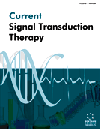- Home
- A-Z Publications
- Current Signal Transduction Therapy
- Previous Issues
- Volume 2, Issue 1, 2007
Current Signal Transduction Therapy - Volume 2, Issue 1, 2007
Volume 2, Issue 1, 2007
-
-
Extracellular Matrix and Aberrant Signaling in Lung Carcinoma: Role of Fibronectin in the Control of Human Lung Carcinoma Cell Growth,Apoptosis and Resistance to Therapy
More LessAuthors: Shou Wei Han and Jesse RomanDespite recent advances in understanding the molecular biology of lung carcinoma and the introduction of multiple new chemotherapeutic agents for its treatment, its dismal five-year survival rate (<15%) has not changed substantially. The lack of advancements in this area reflects the limited knowledge available concerning the factors that promote oncogenic transformation and proliferation of carcinoma cells in the lung. Tum Read More
-
-
-
Regulation of Polymorphonuclear Leukocyte-Intestinal Epithelial Cell Interactions: Signalling Events and Potential Drug Targets
More LessBy Paul HofmanA crucial event in the inflammatory response is recruitment of polymorphonuclear leukocytes (PMNL) to a site of infection or injury. PMNL-epithelial interactions involve many fundamental cell processes, including adhesion, migration, secretion, phagocytosis and apoptosis. Thus, migration of PMNL across epithelial-lined organs is a primary event component of host defense. Moreover, PMNL transepithelial migration often resul Read More
-
-
-
Signal Transduction Therapy: Challenges to Clinical Trial Design
More LessAuthors: Syed A. Hussain, Daniel W. Rea, Nicholas D. James and Daniel H. PalmerThe most important change that will emerge over the coming decade for management of cancer is the shift from conventional chemotherapy and radiotherapy to novel targeted therapies. The rapid expansion in the understanding of the molecular biological basis of cancer provides potential targets for novel therapies. Many molecules, with a variety of cellular targets are now entering the clinic with the emergence of some pr Read More
-
-
-
IL-13 and its Signal Pathway: Promising Targets in the Development of a Therapeutic Agent for Bronchial Asthma
More LessAuthors: Kenji Izuhara, Kazuhiko Arima, Sachiko Kanaji, Taisuke Kanaji and Shoichiro OhtaThe incidence of allergic diseases has dramatically increased in recent decades, especially in urban and industrialized areas. It has been reported that, at present, one third of the population in Japan suffers from bronchial asthma, atopic dermatitis, or allergic rhinitis. The medical cost for treating such patients is huge and on the increase. Thus, it is important socially as well as medically to establish more useful strategies t Read More
-
-
-
Cellular Signaling in Cartilage Tissue Engineering
More LessOsteoarthritis is a common disease in humans, which is caused by progressive degradation of articular cartilage and imbalance of extracellular matrix turnover. It usually causes pain and malfunction of the affected joints, and the incidence of this disease increases with aging. Classical treatment for osteoarthritis is pain alleviation and, in progressed disease, surgical operations. New surgical techniques include transplan Read More
-
-
-
The Role of Connexins in Carcinogenesis: Review of Current Knowledge
More LessGap junctional intercellular communication is a mechanism for direct cell-to-cell signaling and is mediated by gap junctions, which consist of transmembrane proteins called connexins. Many physiological roles have been proposed for gap junctions such as maintenance of tissue homeostasis, regulation of tissue development, electrical and metabolic coupling as well as regulation of cellular growth, differentiation Read More
-
-
-
Advances in Molecular Therapeutic Approaches to Patients with Malignant Gliomas
More LessMalignant gliomas remain refractory to conventional treatment approaches, including radiotherapy and cytotoxic chemotherapy. Molecular neuro-oncology has now begun to clarify the transformed phenotype of high-grade gliomas and identify oncogenic pathways that might be amenable to small molecule “targeted” therapy. Growth factor signaling pathways are often up-regulated in these tumors and contribute to oncogen Read More
-
-
-
Glial Reaction in Parkinson's Diseases: Inflammatory Activation Signaling of Glia as a Potential Therapeutic Target
More LessAuthors: Dong-Kug Choi and Kyoungho SukAlthough the main cause of many neurodegenerative diseases is unknown, the glial reaction is considered to be a consequence of neuronal cell death in Alzheimer's disease, Parkinson's disease, and Huntington's disease. In Parkinson's disease, postmortem examination and experimental animal models exposed to neurotoxin reveals a dramatic loss of dopaminergic neurons in the substantia nigra associated with a massive Read More
-
-
-
Signal Transduction Therapy of Diabetic Vascular Complication
More LessDiabetic vascular complication is a leading cause of end-stage renal failure, acquired blindness, a variety of neuropathies and accelerated atherosclerosis, which could account for disabilities and high mortality rates in patients with diabetes. There is a growing body of evidence to conclude that intensive control of plasma glucose and blood pressure is crucial for effectively reducing diabetic vascular complication. S Read More
-
Volumes & issues
-
Volume 20 (2025)
-
Volume 19 (2024)
-
Volume 18 (2023)
-
Volume 17 (2022)
-
Volume 16 (2021)
-
Volume 15 (2020)
-
Volume 14 (2019)
-
Volume 13 (2018)
-
Volume 12 (2017)
-
Volume 11 (2016)
-
Volume 10 (2015)
-
Volume 9 (2014)
-
Volume 8 (2013)
-
Volume 7 (2012)
-
Volume 6 (2011)
-
Volume 5 (2010)
-
Volume 4 (2009)
-
Volume 3 (2008)
-
Volume 2 (2007)
-
Volume 1 (2006)
Most Read This Month
Article
content/journals/cst
Journal
10
5
false
en


